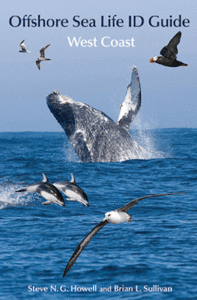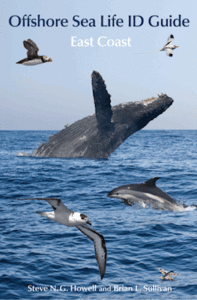Unless you’re a scuba diver or have access to a diving bell, the only in-the-wild view you’re likely to get of the world’s oceans is from above their respective surfaces. Consequently, views of the free living creatures in those oceans will also only be from above the surface of the waters. So when it comes to field guides, while detailed, fully illustrated volumes depicting the marine mammals, fish, and myriad other denizens of the deep are both fascinating for the general reader and essential for the professional one, the vast majority of us – should we find ourselves wishing to identify an ocean-dwelling creature we saw during a pelagic nature trip or vacation cruise – need a field guide written with the specific purpose of depicting just what we might actually see above the surface of the water. Fortunately, thanks to the work of Steve N.G. Howell and Brian L. Sullivan, not just one but two new guides expressly for this purpose have recently been published by Princeton University Press: the Offshore Sea Life ID Guide; West Coast and the Offshore Sea Life ID Guide; East Coast.
Concise and straight-to-the-point, both these new guide books follow the same format; a brief explanation of the oceanic environments over which you or I may reasonably find ourselves and an overview of the various life forms likely (emphasis on the “likely”)to be seen there from above the surface, followed by full-page or three-quarter page digitally compiled photo plates depicting the specific potentially visible bits of the creatures which fit into the afore-mentioned parameters. In the case of marine mammals, particularly whales, these bits are often limited to flippers, tails, and dorsal fins. The remaining sea-dwelling creatures – a smattering of sharks, jellyfish, mola, and turtles – are likewise depicted. Ocean-going birds are, of course, shown in the positions most likely while at sea: paddling on the surface or flying. Each photo plate includes clear and concise notations in an easy-to-read and appropriately contrasting color typeface, and is further explained by a short adjacent paragraph with additional helpful identification notes.
Even beyond the well-considered content and the emphasis on brevity, clarity, and likelihood of visibility, the overall form of these two books themselves clearly indicates that they are meant to be used in the field – or more accurately, on the sea. Small and light enough to be carried in a large pocket but large enough to allow the photos and text to be easily examined and read – even from the deck of a pitching and yawing boat, the form and format of these two new ID guides was quite obviously given considerable forethought.
Given the guides’ authors, such attention to detail is not at all surprising. Howell, author of Petrels, Albatrosses, and Storm-Petrels of North America and The Amazing World of Flying Fish, is also one of the world’s most renowned professional birding and nature guides who has particular expertise in leading pelagic trips, and Sullivan, co-author of The Crossley ID Guide: Raptors, is the program co-director for eBird and editor for Cornell Lab of Ornithology’s Birds of North America Online. Needless to note, both these men are truly experts in field identification of wildlife and thus have the knowledge to know what manner of written and visual materials are valuable in the field and which are not. It is indeed clear that they have applied this considerable amount of knowledge and experience in the creation and publication of these two easily-pocketable, clearly written, and colorfully photo illustrated books.
Anyone planning any manner of sea voyage along the Pacific or Atlantic coasts of North America, from a few-hour-long pelagic nature tour to a week-long (or longer) cruise vacation should make it a point to include the appropriate volume of the Offshore Sea Life ID Guides among their belongings taken onboard. By all means, take a more conventional bird or wildlife guide along as well for more in-depth study as desired, but if you want the best reference tool you can get to make accurate identifications of the most commonly seen marine wildlife, you’ll want one of these guides in your pocket whenever your gaze is cast out over the waves.
 Title: Offshore Sea Life ID Guide: West Coast
Title: Offshore Sea Life ID Guide: West Coast
Authors: Steve N. G. Howell & Brian L. Sullivan
Publisher: Princeton University Press
Format: Paperback
Pages: 56 pp. with 300+ color photos & 1 map
Published: 2015
ISBN: 9780691166131
 Title: Offshore Sea Life ID Guide: East Coast
Title: Offshore Sea Life ID Guide: East Coast
Authors: Steve N. G. Howell & Brian L. Sullivan
Publisher: Princeton University Press
Format: Paperback
Pages: 64 pp. with 120 color photos
Published: 2015
ISBN: 9780691166216
In accordance with Federal Trade Commission 16 CFR Part 255, it is disclosed that the copy of the book read in order to produce this review was provided gratis to the reviewer by the publisher.
